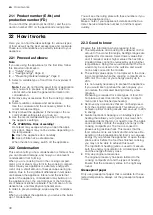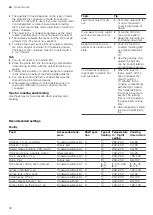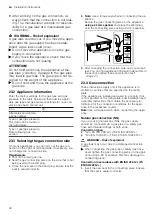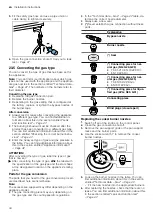
en
How it works
40
Meal
Accessory/
cookware
Shelf posi-
tion
Type of
heating
Temperature
in °C
Cooking time, minutes
Pomes, e.g. apples, straw-
berries, gooseberries
1-litre pre-
serving jars
2
1.
170–180
2.
-
1.
Until it starts bubbling:
30–40
2.
Residual heat: 25
Pureed fruit, e.g. apples,
pears and plums
1-litre pre-
serving jars
2
1.
170–180
2.
-
1.
Until it starts bubbling:
30–40
2.
Residual heat: 35
22.14 Proving dough
You can prove yeast dough more quickly in your appli-
ance than at room temperature.
Proving dough
Always allow yeast dough to prove in two steps: Once
in its entirety (dough fermentation) and a second time
in the baking tin (final fermentation).
1.
Place the dough into a heat-resistant bowl.
2.
Place the bowl on the wire rack.
3.
Use the recommended settings when configuring
the appliance settings.
Only start operation when the cooking compartment
has fully cooled down.
4.
Do not open the appliance door while the dough is
proving, otherwise moisture will escape.
5.
Continue processing the dough and mould it into
the final shape for baking.
6.
Place the dough into the cooking compartment at
the specified shelf position.
Tip:
If you want to preheat the oven, do not carry out
the final proving stage in the appliance.
Recommended settings
Proving dough
The temperature and time are dependent on the type and quantity of the ingredients. The values in the table are
therefore guide values only.
Meal
Accessory/cookware Shelf posi-
tion
Type of
heating
Temperature
in °C
Cooking time,
minutes
Yeast dough, light
1.
Bowl
2.
Universal pan
1.
2
2.
2
1.
2.
1.
50
1
2.
50
1
1.
25–30
2.
10–20
Yeast dough, heavy and rich
1.
Bowl
2.
Universal pan
1.
2
2.
2
1.
2.
1.
50
1
2.
50
1
1.
60–75
2.
45–60
1
Preheat the appliance for 5 minutes.
22.15 Test dishes
These overviews have been produced for test institutes
to facilitate appliance testing in accordance with EN
60350-1.
Baking
Please take note of the following information if you are
baking test dishes.
General information
¡
The setting values apply to food placed in the cook-
ing compartment while the cooking compartment is
still cold.
¡
Observe the notes about preheating in the tables.
These setting values assume that the rapid heating
function is not being used.
¡
When baking, use the lower of the listed temperat-
ures to begin with.
Shelf positions
Shelf positions for baking on one level:
¡
Universal pan/baking tray: Shelf position 3
¡
Baking tins on the wire rack: Shelf position 2
Baking with two springform cake tins:
If you can use your appliance to cook on multiple
levels, position baking tins either next to one another or
offset on different shelves so that they are not directly
one above the other in the cooking compartment.













































